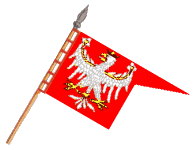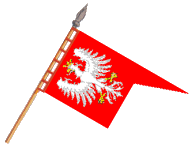
Last modified: 2002-10-12 by jarig bakker
Keywords: poland | royal banners | lithuania | sweden | saxony |
Links: FOTW homepage |
search |
disclaimer and copyright |
write us |
mirrors
![[banner of Wladyslaw Lokietek]](../images/p/pl_wl.gif) by Adam Kromer, from his
site.
by Adam Kromer, from his
site.
Władysław IV the Short (1320-1333) was the ruler of Kujavia in central
Poland, who reunified the Polish kingdom. He inflicted a severe defeat
on the Teutonic Knights at Plowce in 1331.
Jarig Bakker, 23 Sept 2000
![[banner of Kazimierz Wielki]](../images/p/pl_kw.gif) by Adam Kromer, from his
site.
by Adam Kromer, from his
site.
Kasimir III the Great (1333-1370), son of Władysław IV, was the most
distinguished of Polish medieval kings.
Jarig Bakker, 23 Sept 2000
![[banner of Wladyslaw Jagiello]](../images/p/pl_wj.gif) by Adam Kromer, from his
site.
by Adam Kromer, from his
site.


Władysław V Jagiełło (of Lithuania) (1386-1434) acquired the Polish
throne through mariage to the Angevin dynasty; famous for his great victory
over the Teutonic Knights of Prussia in 1410 at Grunwald (Tannenberg).
Jarig Bakker, 23 Sept 2000
![[banner of Grand Duchy of Lithuania]](../images/p/pl_wkl.gif) by Adam Kromer, from his
site.
by Adam Kromer, from his
site.
Lithuania was dynastically united with Poland in the late 14th century
under the Jagiełło family; the two states were constitutionally linked
by the Union of Lublin in 1569.
Jarig Bakker, 23 Sept 2000
![[Banner of Kazimierz Jagiellonczyk]](../images/p/pl_kj.gif) by Adam Kromer, from his
site.
by Adam Kromer, from his
site.
Kazimier IV (1447-1492) after a long war with the Teutonic Knights imposed
on them the Peace of Thorn (1466). by which Poland acquired Malbork (Marienburg)
and Gdańsk (Danzig) and access to the sea. In 1471 he was able to vindicate
his son's claim to the throne of Bohemia, to which the younger Władysław
later added Hungary.
Jarig Bakker, 23 Sept 2000
![[Banner of Zygmunt August]](../images/p/pl_za.gif) by Adam Kromer, from his
site.
by Adam Kromer, from his
site.
Under Zygmunt August (Sigismund II Augustus) (1548-1572) Calvinism spread
widely in Poland until in 1565 the Counter-Reformation took over and Catholicism
was re-established. In 1569 the Union of Lublin welded all provinces into
an indissoluble entity under an elected sovereign.
Jarig Bakker, 23 Sept 2000
![[banner of Zygmunt III Waza]](../images/p/pl_zw.gif) by Adam Kromer, from his
site.
by Adam Kromer, from his
site.
Zygmunt III Waza (Sigismnund III Vasa of Sweden) (1587-1632) established
the Uniate Church in 1596, whereby a large body of his Orthodox subjects
accepted the supremacy of Rome.
Jarig Bakker, 23 Sept 2000
In Swedish he was called Sigismund (without any number; he is so far
the only Swedish king by that name). He was king of Sweden 1592-1599.
Elias Granqvist, 11 Aug 2001
![[personal banner of Zygmunt III Waza]](../images/p/pl_zw2.jpg) by Adam Kromer, from his
site.
by Adam Kromer, from his
site.
Royal Flag of Poland (1605). (personal flag of King Sigismund III).
Source: this website.
Hope you can add it to one of the Polish sites.
The site shows a beautiful flag, more elaborated than this
one, and mentions as source: Alfred Znamierowski's Book The World Encyclopedia
of Flags (p. 56).
Andrew Andersen, 7 Oct 2002
![[Banner of Wladyslaw IV Waza]](../images/p/pl_ww.gif) by Adam Kromer, from his
site.
by Adam Kromer, from his
site.
Władysław IV Waza (1632-1648), son of Zygmunt III and king of Poland
and Sweden.
Jarig Bakker, 23 Sept 2000
It should be noted, that Wladislaw IV never was king of Sweden. This
was only a title of pretence. His father had been king of Sweden, but was
disposed when he wanted to turn Sweden catholic.
Elias Granqvist, 11 Aug 2001
![[Banner of Kingdom of Poland during Saxon reign]](../images/p/pl_kp.jpg) by Adam Kromer, from his
site.
by Adam Kromer, from his
site.
Elector Frederick Augustus of Saxony was elected King of Poland in 1697
as Augustus II. Kings of Saxony reigned Poland until 1764.
Jarig Bakker, 23 Sept 2000
![[Banner of Stanislaw August Poniatowski]](../images/p/pl_sp.gif) by Adam Kromer, from his
site.
by Adam Kromer, from his
site.
Stanisław August Poniatowski (Stanislav II, 1764-1795) saw chaos continuing
in Poland and Prussia and Russia saw to it that Poland did not exist anymore
at the end of his reign.
Jarig Bakker, 23 Sept 2000